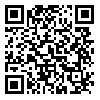Volume 21, Issue 3 (9-2021)
ijdld 2021, 21(3): 151-164 |
Back to browse issues page
Download citation:
BibTeX | RIS | EndNote | Medlars | ProCite | Reference Manager | RefWorks
Send citation to:



BibTeX | RIS | EndNote | Medlars | ProCite | Reference Manager | RefWorks
Send citation to:
Kazemi A, Bahador H. Provide a Predictive Model to Identify People with Diabetes Using the Decision Tree. ijdld 2021; 21 (3) :151-164
URL: http://ijdld.tums.ac.ir/article-1-6032-en.html
URL: http://ijdld.tums.ac.ir/article-1-6032-en.html
1- Department of Industry - Faculty of Industry, Islamic Azad University, Qazvin Branch, Qazvin, Iran
2- Department of Computer, Technical and Vocational University, Khoy Branch, Iran ,hamidbahador52@gmail.com
2- Department of Computer, Technical and Vocational University, Khoy Branch, Iran ,
Abstract: (1411 Views)
Background: Today, in most hospitals in Iran, there is an extensive database of patient characteristics that includes a large amount of information related to medical, family and medical records. Finding a knowledge model of this information can help to predict the performance of the medical system and improve educational processes.
Methods: Data mining techniques are analytical tools that are used to extract meaningful knowledge from a large data set. In this study, the information of 500 people referred to Shahid Bolandian Health Center in Qazvin has been used. In this research, a predicted model has been performed using decision tree data mining methods and neural network and Bayesian network.
Results: The decision tree model has the highest accuracy and the Bayesian network has the lowest accuracy in diagnosing diabetic patients, and consequently the decision tree has the least error and the Bayesian network has the highest error. The decision tree model with 95.68% had the highest accuracy in prediction.
Conclusion: Fat has the greatest effect in predicting diabetes and gender has the least effect in predicting diabetes. Based on the decision tree analysis, the rules obtained among the stated characteristics of age and sugar variables have the greatest effect in predicting the occurrence of diabetes (according to software analysis) and by creating a proper diet can prevent this disease Prevented.
Methods: Data mining techniques are analytical tools that are used to extract meaningful knowledge from a large data set. In this study, the information of 500 people referred to Shahid Bolandian Health Center in Qazvin has been used. In this research, a predicted model has been performed using decision tree data mining methods and neural network and Bayesian network.
Results: The decision tree model has the highest accuracy and the Bayesian network has the lowest accuracy in diagnosing diabetic patients, and consequently the decision tree has the least error and the Bayesian network has the highest error. The decision tree model with 95.68% had the highest accuracy in prediction.
Conclusion: Fat has the greatest effect in predicting diabetes and gender has the least effect in predicting diabetes. Based on the decision tree analysis, the rules obtained among the stated characteristics of age and sugar variables have the greatest effect in predicting the occurrence of diabetes (according to software analysis) and by creating a proper diet can prevent this disease Prevented.
Type of Study: Research |
Subject:
Special
Received: 2021/01/15 | Accepted: 2021/08/30 | Published: 2021/09/1
Received: 2021/01/15 | Accepted: 2021/08/30 | Published: 2021/09/1
Send email to the article author
| Rights and permissions | |
 |
This work is licensed under a Creative Commons Attribution-NonCommercial 4.0 International License. |






